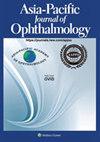咖啡因在减缓近视进展中的作用:一项前瞻性纵向临床试验的1年结果。
IF 4.5
3区 医学
Q1 OPHTHALMOLOGY
引用次数: 0
摘要
目的:确定外用咖啡因在减缓近视进展中的作用,无论是单独治疗还是与阿托品联合使用。方法:在一项前瞻性、随机、配药的临床试验中,96名6-13岁的近视儿童,眼球度数(SE)从-0.50屈光度(D)到-6.00 D,散光小于2.00 D,随机分配到每晚使用2 %咖啡因、0.02 %阿托品与2 %咖啡因(联合)或0.02 %阿托品滴眼液。另外86名近视儿童被纳入同时平行组,佩戴单视力(SV)眼镜。主要结果是每组在12个月内SE和轴向长度(AL)的变化。结果:两组近视均有进展。在12个月内,平均变化SE / AL -0.76 ±0.51 D / 0.37 ±0.20 毫米和-0.70±0.55 D / 0.35±0.23 mm SV和2 %咖啡因,分别。相比,进展慢-0.46 ±0.50 D / 0.24 ±0.19 毫米和-0.47±0.38 D / 0.23 ±0.18 毫米与单一疗法和组合阿托品组,分别。与SV组AL的变化相比,0.02 %阿托品组和联合组AL的变化明显小于0.02 %阿托品组(事后分析,P = 0.024和0.007)。同样,与SV组相比,0.02 %阿托品的SE变化显著小于SV组(P = 0.027)。结论:单独使用2 %咖啡因治疗不能减缓近视进展。当与阿托品联合使用时,咖啡因对阿托品减缓近视的效果没有影响。本文章由计算机程序翻译,如有差异,请以英文原文为准。
Role of caffeine in slowing progression of myopia: 1-year results from a prospective, longitudinal clinical trial
Purpose
To determine the role of topical caffeine in slowing progression of myopia, both as a standalone treatment and in combination with atropine.
Methods
In a prospective, randomized, dispensing clinical trial, 96 children with myopia, aged 6–13 years, spherical equivalent (SE) from –0.50 diopters (D) to –6.00 D and astigmatism less than 2.00 D were randomly assigned to nightly use of either 2 % caffeine, 0.02 % atropine with 2 % caffeine (combination) or 0.02 % atropine eye drops. An additional 86 children with myopia were enrolled in a concurrent parallel group to wear single-vision (SV) spectacles. The primary outcomes were changes in SE and axial length (AL) over a period of 12 months for each group.
Results
All groups progressed in myopia. At 12 months, the mean change in SE/AL was –0.76 ± 0.51 D / 0.37 ± 0.20 mm and –0.70 ± 0.55 D / 0.35 ± 0.23 mm with SV and 2 % caffeine, respectively. In comparison, progression was slower at –0.46 ± 0.50 D / 0.24 ± 0.19 mm and –0.47 ± 0.38 D / 0.23 ± 0.18 mm with atropine monotherapy and combination groups, respectively. Compared to the change in AL with SV, the change in AL was significantly less with 0.02 % atropine and the combination group (post hoc analysis, P = 0.024 and 0.007, respectively). Similarly, the change in SE was significantly less with 0.02 % atropine compared to the SV group (P = 0.027).
Conclusions
Used as a standalone treatment, topical 2 % caffeine did not slow myopia progression. When combined with atropine, caffeine had no impact on the efficacy of atropine in slowing myopia.
求助全文
通过发布文献求助,成功后即可免费获取论文全文。
去求助
来源期刊

Asia-Pacific Journal of Ophthalmology
OPHTHALMOLOGY-
CiteScore
8.10
自引率
18.20%
发文量
197
审稿时长
6 weeks
期刊介绍:
The Asia-Pacific Journal of Ophthalmology, a bimonthly, peer-reviewed online scientific publication, is an official publication of the Asia-Pacific Academy of Ophthalmology (APAO), a supranational organization which is committed to research, training, learning, publication and knowledge and skill transfers in ophthalmology and visual sciences. The Asia-Pacific Journal of Ophthalmology welcomes review articles on currently hot topics, original, previously unpublished manuscripts describing clinical investigations, clinical observations and clinically relevant laboratory investigations, as well as .perspectives containing personal viewpoints on topics with broad interests. Editorials are published by invitation only. Case reports are generally not considered. The Asia-Pacific Journal of Ophthalmology covers 16 subspecialties and is freely circulated among individual members of the APAO’s member societies, which amounts to a potential readership of over 50,000.
 求助内容:
求助内容: 应助结果提醒方式:
应助结果提醒方式:


